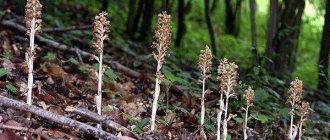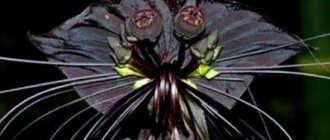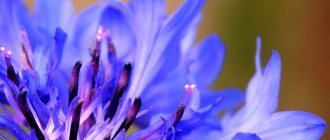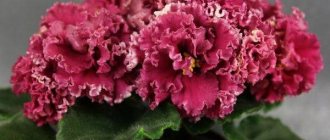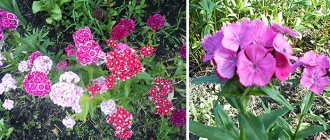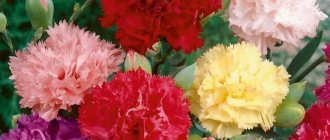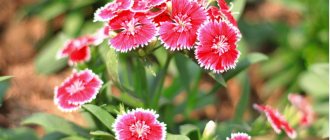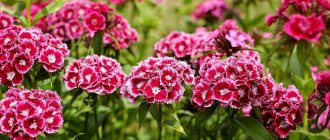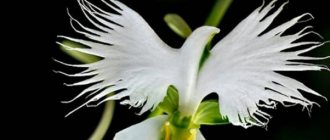The carnation is a modest, delicate flower with a soft and enchanting charm. However, its name is not at all modest - in Latin, carnation is “Dianthus”, which means “Flower of God”. It was believed that the Gods of Olympus were crazy about these cute flowers. The religious significance of carnations is difficult to overestimate - at all times, representatives of different faiths used carnations for rituals, since it was believed that the flower is the earthly embodiment of the divine.
During World War II, the carnation became a symbol of innocently shed blood and honoring the memory of the dead. In the USA, carnations are traditionally given on Mother's Day - there the flower means gratitude for the unconditional love of parents. But in China, white carnations are considered wedding flowers - they are used to decorate the bride’s outfit.
In Korea, fortune telling with carnations is popular among young girls. Young beauties weave three buds of these amazing flowers into their hair. If the top flower withers first, the girl will face a difficult, difficult old age, if the middle one, the most difficult times will be at a young age, and if the bottom one withers first, failures will lie in wait throughout her life.
Often the meaning of carnations depends on the color of the petals. White flowers are a symbol of trust, sincerity and purity of thoughts, red ones are, of course, a sign of ardent and passionate love, but striped flowers are a kind of “consolation prize” for the person you are forced to refuse.
For some reason, in our country these flowers are associated only with cemeteries and Victory Day. Of course, carnations are great for expressing gratitude and sorrow, however, their role is not limited to this. They look great both at holidays and as an expression of feelings - you just have to abandon the usual patterns. These inexpensive flowers have a special charm - be able to notice this without thinking about how many people are accustomed to interpret the meaning of carnations due to lack of awareness.
Regardless of what meaning you attach to flowers, you have to agree that carnations have a unique aesthetic. In our selection we will introduce you to the most beautiful varieties of this plant.
Heddeviga chinensis
In the nineteenth century, large-flowered carnations were brought to Russia from Japan, which were later called “Geddevia sinensis” - in honor of Karl Heddevig, who was a gardener at the St. Petersburg Botanical Garden. These unpretentious flowers can tolerate anything - frost and drought, although they still need care and feeding. Heddeviga chinensis will decorate any garden plot and fit perfectly into the landscape. Flower growers adore this plant - and, it must be said, for good reason, because thanks to Chinese carnations they do not have to make a choice between aesthetics and ease of maintenance. If you decide to decorate your flowerbed with Hedwiga sinensis, plant the flowers on the sunny side - this will ensure good growth.
Planting carnations
Carnations transplanted in spring will bloom only the next year. The best time to plant an adult plant: September - early October. The bush must have time to take root before the onset of cold weather.
Priming
Field carnation loves dry soils. That is why it needs to be planted in sunny, well-warmed and drained areas. The soil should be loose, neutral or slightly alkaline, fertile, but not heavy.
Temperature
It is better to sow seeds only in spring. Of course, this can be done in the fall, but then there will be a danger of seeds germinating before winter, for example, during a long late autumn. Such sprouts may not survive freezing temperatures.
Watering
This plant is well adapted to dry conditions, but can also withstand temporary waterlogging. The roots of the field carnation are located very close to the surface of the earth, so the bushes of this plant can be fed for quite a long time from the water that comes with the dew.
Merry go round
The beauty of the large white flowers with a red spot in the middle is truly mesmerizing. Merry go round is a variety that looks festive, joyful, and creates a special atmosphere. If you have been missing something that can help fight depression and feed positivity from the outside, pay attention to these carnations. They look especially impressive in a flowerpot on the porch. Neat, small flowers will appeal to those who are looking for something bright, but at the same time not too provocative.
Signs and superstitions
Cloves have many magical properties, one of which is protection from negative energy, hostile influences and witchcraft. In addition, this flower can stop gossip and bad language. Carnations also strengthen memory well, and if you make a necklace of buds and string them on a red thread, this will become a good amulet for young children.
Also, the smell of cloves “helps smooth out internal contradictions” and “stimulates positive emotions”
In the Middle Ages, when the Catholic Church organized a witch hunt, only the carnation could protect people with extraordinary abilities (for this you had to always carry this flower with you). Naturally, cloves were actively used in various protective spells and magical rituals. It was given to a sick person, as it was believed that this flower had strong healing properties.
Cloves (or rather the inflorescences and roots of the plant) were also used as a love spell, and clove amulets contributed to self-improvement, the development of confidence and perseverance. In addition, cloves help to cope with indecision and enhance vitality.
Marie Chabot
We owe the opportunity to contemplate such beauty to the pharmacist Chabot from Toulon, who lived in the nineteenth century. Yellow flowers will perfectly decorate a flower bed, balcony, terrace, gazebo. If you are the owner of a small cozy cafe, we recommend this particular variety to decorate the landscape of the establishment. However, flowers are also suitable for cutting - after all, what girl would refuse the opportunity to receive a bouquet of sunny carnations? Marie Chabot are flowers with a subtle, refined aroma, and if you are partial to smells, pay attention to this variety.
Useful properties of wild cloves
Field clove is rich in: vitamin C, flavonoids, saponins, alkaloids, coumarins. This plant has: anti-inflammatory, hemostatic, sedative, diuretic and choleretic effects. In folk medicine, cloves are recommended for:
- cold; rapid heartbeat;
- heart pain and palpitations;
- headache; nervous breakdowns;
- painful and heavy menstruation; anemia of the uterus; infertility;
- postpartum hemorrhage; inflammatory processes in the genital organs of men and women;
- stomach ache; flatulence; hemorrhoids; kidney diseases;
- jaundice; malaria; decreased immunity;
- eye diseases; toothache.
Wild cloves are also used in cosmetology: to prevent premature aging and acne.
Uses of cloves
Its hemostatic, anti-inflammatory, diuretic, astringent and analgesic effects are widely known today in folk medicine. The ability of this plant to increase uterine tone has been clinically proven. Clove-based products are recommended to be taken for uterine bleeding that occurs in the postpartum period.
The peoples of Central Asia often use cloves to treat bites from rabid animals. This is an effective means of preventing infection. In addition, field clove has a calming effect, so it is used as a cardiovascular remedy for excessive nervousness and excitability.
Cooking recipes
To prepare an infusion of cloves, take a tablespoon of dry medicinal raw material and pour it with a glass of water. The mixture must be boiled for 2-3 minutes and left for an hour. Take two tablespoons 3 times a day. This is a good treatment for gastritis and cystitis. The infusion helps stop bleeding of various origins.
To get clove tea The tea is infused for about an hour. Tea with cloves has a positive effect against coughing attacks.
extract is prepared from a decoction of the plant. It needs to be boiled to half and taken a teaspoon three times a day. This treatment helps with severe coughs and colds.
You can make homemade clove oil For this you need olive oil and dried crushed herbs. The ingredients are mixed in proportions of 10:1 and infused for 10 days. Take 5-10 drops of oil three times a day.
Contraindications
Field cloves are contraindicated:
- children under two years old;
- pregnant and lactating women;
- with hypotension;
- for gastritis and ulcers of the stomach and duodenum.
Mikado
The “Mikado” variety is sure to become your favorite if you prefer delicate, discreet flowers. The lilac shade looks both gentle and mysterious - by the way, this color is considered the most fashionable in the summer of 2020. These flowers are well suited both for decorating the veranda and for cutting - lilac bouquets look simply amazing. We must warn you that this variety is not so easy to care for - this is unlikely to scare experienced plant growers, but beginners should choose something simpler. During the rainy season, fungal diseases in flowers are possible.
Fire King
There is a belief that this particular variety protects the home from evil spirits and prevents misfortunes on the road. It also symbolizes kindness, justice, loyalty and devotion. Large red-orange flowers look catchy, impressive and bright - so we must warn that they cannot fit into any scale, as they can draw all the attention to themselves. The aroma of these flowers will not leave anyone indifferent, so we would recommend them for cutting and gifting. If you want to please a sultry, extravagant and temperamental girl, give her “Fire King” carnations.
Hello, dear readers!
Just one breath - and sorrows are forgotten! What colors do you think this can be said about?
Of course, about the tart, teasing and exciting aroma of cloves. This smell is like a bundle of energy, inhalation and laughter already sparkling in the eyes.
Inhaling further without stopping, we become intoxicated with the feeling of joy, life, love. And it doesn’t matter that the morning was cloudy, and the day as a whole was not going well - all this is already in the past.
It’s not without reason that the Latin name of the carnation is translated as “divine flower.”
Many legends are associated with the carnation, a plant that decorates many gardens and front gardens and is well known to gardeners.
From romantic to terrifyingly bloody. And the associations are different: for some, flowers will bring back tender memories, for others they will evoke bitter emotions. And all this is her, the carnation. Native of different places.
Carnations are like people: representatives of the same species, but have different homelands.
The garden carnation traces its lineage to the Mediterranean. Its wild relatives grow there.
Chinese - Chinese, the homeland of some of its subspecies is Japan.
There is also our original, Primorsky Chinese carnation. Such an incident with the name of the species is called Chinese, and the origin is “international”.
The territorial proximity of these regions determined the similarity of their climate and contributed to the spread of cloves.
La France
La France is considered one of the best varieties of pink carnations. The delicate powdery shade looks incredibly gentle and elegant. The bushes are tall, the variety is well suited for cutting. The aroma is very pleasant, fresh and spicy at the same time. We advise you to pay attention to “La France” if you want to enjoy flowering for as long as possible - these carnations can delight you right up to October.
A closer look at the noble flower
How nice it is that caring people take a close look at the plant kingdom around us. Their admiration is reflected in songs and poems that remain on the lips of several generations for a long time. What attracts the prim carnation? With its originality.
Interestingly, the flower was called “carnation” by German plant researchers. The reason for this was the exquisite smell that the plant exuded, reminiscent of the oriental spice of the clove tree. In fact, the plants have nothing in common.
The famous Swedish botanist Carl Lineus, admiring the unusual flower, gave it the name “Dianthus”. Translated into Russian it means “divine flower”. Today, there are over 300 different species of carnations in the natural environment. They are all classified as annuals, biennials and perennials, which have different characteristics. The only thing they have in common is the magnificence of their elegant buds.
Considering different varieties of the plant, biologists discovered that carnation flowers are:
- in a single version;
- in the form of a panicle;
- luxurious shield;
- small;
- large;
- simple;
- terry;
- with a pleasant smell;
- no aroma;
- with smooth petals;
- with serrated tips of inflorescences.
The calyx of the bud has the shape of a miniature cylinder. In its upper part there are 5 tiled petals of various colors. They surround ten graceful stamens and one slender pistil. Each petal has a velvet base, the edges of which are decorated with original fringe. Truly a majestic flower!
The original shoots of cloves are:
- smooth structure;
- herbaceous in nature;
- with the presence of nodules;
- single;
- with many branches;
- slightly woody.
They grow linear leaves located opposite each other in various green shades. In some species they are grassy in color, in others they are dark green. But they are all covered with a bluish-silver coating.
When the flowering period passes, fruits appear on the plant in the form of miniature boxes. They are filled with a huge number of shiny black or brown seeds. Interestingly, they can be round, oval or flattened. But this does not in any way affect the germination of the seeds; each of them carries information about the original variety of carnation.
The flower is widely used for landscape design of garden areas. They decorate borders, rock gardens, flower beds and lawns. The plant grows well through the seams of paving slabs, making it an indispensable outdoor decoration.
Canta libra
Very expressive, spectacular and bright carnations. Plant growers claim that the Canta Libra variety is hardy and easy to care for. These are miniature flowers that go well with other plants and harmoniously complement their beauty - pay attention to this when composing bouquets. If you are going to decorate the clearing around your house, these crimson and red flowers will be an excellent solution. However, be careful when weeding - due to the modest size of these carnations, they will simply not be visible in thickets of grass.
Seeds and seedlings
Seeds of annual plants are planted in boxes in early spring. Carnation seedlings will appear in 2-3 months, but only with the onset of warm weather are the seedlings placed in open ground. Turkish and Shabo carnations are sown in February, and perennial garden plants in March.
Biennials such as Turkish and Grenadine are planted in open ground in May, but these plants will bloom only the following summer.
Seeds
To plant seeds, you will need containers with a moist substrate of soil and sand in a 2:1 ratio. Due to the small size of the seeds, they are sown on the surface of the soil and lightly crushed with earth, moistening the substrate with a spray bottle. A weak solution of potassium permanganate will help protect seeds from fungal diseases. The containers are covered with polyethylene and placed in a warm, bright place. When the seeds sprout, the greenhouses are opened.
Seedlings are planted in small pots at a distance of at least 5 cm from each other , watered periodically and ensure that the ambient temperature does not fall below 20 °C. Lower air temperatures slow down seedlings.
Maiden pink
The “Maiden Pink” variety is a wonderful decoration for a flower bed or flower garden. These are miniature carnations that bloom profusely. They are absolutely unpretentious in care and are suitable for beginner plant growers. “Maiden Pink” is not as popular as “Canta Libra” - therefore it is suitable for those who want to emphasize their originality. Small crimson flowers look bright and delicate at the same time.
Flower pick
Picking takes place in two stages. The first time they dive after the appearance of two normally developed leaves, the second time after four leaves have formed.
Picking is carried out according to the following scheme:
- the soil with young seedlings is watered abundantly;
- small drainage holes are made in the prepared containers, after which they are filled with substrate;
- small depressions are made in the ground for the root system of the seedling; they should be slightly larger than the roots;
- The sprout is moved to a new container and the substrate is slightly compacted.
After the plant adapts, you can use growth stimulants.
Canary
The “Canary” variety with bright lemon petals is one of the best for garden decoration. Like most varieties of carnations, “Canary” prefers sunny, well-lit areas. In the wild, these flowers can be seen in Italy, Hungary and Romania. Small yellow flowers have a modest, delicate beauty. Flowering begins in mid-July and ends by September.
Variety of species
Varieties of perennial carnation are quite numerous and include about 350 names. Of these, there are 10 most popular ones, which were bred by breeders taking into account the conditions of a temperate climate.
Good to know: How to cover rose bushes for the winter
Alpine
Alpine carnations are a low-growing perennial native to the eastern Alps. It is one of the most unpretentious representatives of the species, tolerates adverse weather conditions well and can grow freely on rocky, depleted soils.
It blooms profusely in the first half of summer with pink inflorescences about 5 cm in diameter. With proper care, it blooms again in August. The plant is perennial, the average lifespan is 5 years.
American
American carnations are remontant and bloom continuously throughout the year. To do this, in winter it is transferred to a moderately warm, well-ventilated room with sufficient lighting.
These varieties are not propagated by layering, but only by cuttings. The event is carried out from mid-summer to the beginning of the second half of September. But if necessary, spring cuttings can also be carried out in March–April.
For propagation, greenhouses are used with the arrangement of beds on the ground, in which the flowering of young plants begins in spring or autumn. For winter flowering, containers with seedlings are placed on racks.
Related article:
Turkish carnation - description and characteristics of perennial garden flowers
Difficulties with growing American in Russia most often appear in the northern regions due to lack of light in winter. In the rest of the territory it is bred without problems.
Dutch
Dutch carnation is a biennial crop with the tallest bushes for ornamental varieties, which can grow up to 80 cm. The inflorescences are also distinguished by their large size and splendor due to their terry nature.
These varieties are valued for the following qualities:
- unpretentiousness;
- increased decorativeness;
- variety of greenhouse varieties;
- versatility when used in landscape design.
For good development, moist, nutritious soil and plenty of light are required. Under such conditions, the flowering period continues throughout the summer.
Chinese
The perennial bush carnation stands out in the flowerbed with rather long paired, curled leaves in some varieties and two-colored or single-colored flowers with a border. Valued for long-lasting and, under optimal conditions, continuous flowering.
Has a light aroma. In home floriculture, the most common are dwarf varieties with a height of up to 20 cm and lush flowering, as well as the Heddevig variety with spherical bushes up to 35 cm and large, densely double flowers.
Knapp
Knappa is a species of garden carnation in the form of a perennial subshrub, which in nature grows mainly on the grassy slopes of South-Eastern Europe. It is the only representative of this variety with pale yellow petals, but there are also varieties with white flowers.
The flowers are small (up to 2 cm) with multi-toothed petals. They bloom at the end of June and fade in mid-August. With the seed propagation method, color appears in the next season after planting. Knappa is resistant to frost, tolerates drought well, but dies when over-moistened.
Lesnaya
Forest carnation is a herbaceous perennial that grows in the form of a dense bush or dense turf up to 30 cm high. It is distinguished by the presence of numerous short shoots and bluntly ribbed erect peduncles covered with small narrow-ovate convex leaves.
Related article:
Turkish cloves: 9 growing features
The flowers are solitary, small or medium in size, without fragrance, predominantly deep pink in color. They bloom throughout the summer.
The plant is light-loving, drought-resistant and frost-resistant (down to –29°C). Does not require shelter for the winter.
Cirrus
Cirrus carnations are one of the most spectacular representatives of this family grown in the garden and country house. There are varieties with single or collected in inflorescences, simple or densely double flowers.
The flowering period is long - from mid-May to early autumn. The curtain grows over 5–6 years, growing significantly in size, but not exceeding a height of more than 30 cm.
The Terry Carpet variety is especially decorative, the appearance of its plantings fully corresponds to its name. The plant loves light, is not afraid of frost, and needs sufficient but moderate moisture to prevent moisture stagnation.
Travyanka
This variety of perennial carnation is characterized by the presence of two types of stems:
- non-flowering, on which only leaves grow - narrow, linear, sometimes with a reddish tint;
- flowering - with inflorescences at the top.
The flowers are pink or scarlet in color and can be plain, variegated or with a rim. The flowering period is one of the longest - from early summer to mid-autumn.
The brightest variety is Moulin Rouge. It combines the beauty of rose petals very successfully with an incredible aroma. Flowering is abundant and just as long.
Turkish
Turkish types of garden carnations are the most common among all other representatives of the crop grown in Russia. Their attractiveness is due to the colorful flowers, each petal of which combines different shades. At the same time, they form very large spherical inflorescences with a diameter of up to 15 cm. The height of the stems varies between 15–60 cm and depends on the varietal characteristics.
Related article:
Turkish carnation - description and characteristics of perennial garden flowers
During the first year after germination, dense bushes are formed, consisting of basal leaf rosettes. In the second year, straight peduncles form and abundant flowering begins, which lasts 2 months (June–July).
Shabo
Shabot is a hybrid perennial in the form of a bush 40–60 cm high, on which long leaves and double flowers grow. The flowering period is quite long - from mid-summer to frost.
The most popular hybrids in home floriculture are F1. They form low compact bushes, densely covered with densely double flowers. For lush and long flowering, plants must be regularly fed with complex mineral preparations.
Yellow harmony
Another wonderful variety for those who adore flowers of a beautiful sunny shade. The petals are very bright - such carnations perfectly lift your spirits and charge you with optimism. The bushes are tall, with erect stems. “Yellow Harmony” has a very pleasant aroma. However, we would not recommend this variety to those growers who are afraid of annoying insects - these carnations are very attractive to them.
Carnation flowers in cooking
The tender petals of garden or Chinese cloves are used for food. These edible flowers are slightly sweet in taste and very fragrant. Before using them as food, remove the base of the petal as it has a bitter taste.
What other flowers can be eaten, read the article:
"Edible flowers and their types"
Chartreuse - traditional French liqueur
With colorful petals, you can liven up your casseroles, salads and sandwiches. Cloves can be used as a spice and added to wine to make mulled wine. Clove petals can also be candied and used in cakes and other sweet baked goods as a living decoration.
During the Renaissance (15th-17th centuries), clove petals became the main ingredient of Chartreuse , a liqueur prepared by the monks of the Carthusian order in the wine cellars of the commune of Voiron on the border of the Chartreuse mountain range in the Pre-Alps.
Ruby
Suitable for those who are looking for flowers that can decorate the site all year round - even when flowering ends, the “Ruby” variety still looks decorative due to the bluish-blue color of the leaves. The flowers are small, but look very festive and cheerful. The rich ruby hue will attract aesthetes who admire deep, rich tones. We must warn you that the variety does not tolerate high humidity, so try to provide the plant with good drainage. Oddly enough, these carnations feel great in sand or rocks.
Preparing seeds and soil
You can buy clove seeds at the store or collect them from your own plants. If faded inflorescences are not removed after flowering, seed pods will ripen on them. When they begin to crack, the spilled seeds are collected, dried and stored in dry jars or paper bags. Good germination is maintained for 3 years.
Before sowing old seeds, it is recommended to soak them in Epin solution (4 drops per glass of water) for 2 hours. Fresh seeds can be soaked in warm water, then placed in a warm place for germination, wrapped in a wet cloth. Germination time is 3-5 days.
To sow cloves, use plastic containers 5-7 cm high, with drainage holes in the bottom.
You can buy ready-made soil intended for flowers, or you can make a mixture yourself. Cloves need loose, light and nutritious soil. You will need the following components:
- 1 part peat;
- 1 part vermicompost or mature compost;
- 1.5 parts of turf humus;
- 1 part sand (perlite).
To protect plants from infection, the soil before sowing is calcined in the oven for half an hour or watered generously with a hot raspberry solution of potassium permanganate.
Carnations are sensitive to stagnant moisture in the soil, so drainage holes in the seedling container alone are not enough. Additionally, a little fine expanded clay or gravel is poured onto the bottom.
Weiss
An excellent decoration for a wedding bouquet - lush white inflorescences look luxurious, expensive and solemn. At the same time, these carnations are the real personification of tenderness. The “Weiss” variety is also ideal for decorating a personal plot - it has long flowering and will delight you for a long time. The aroma of flowers is delicate, subtle, refined. Unlike most other varieties of carnations, the Weiss variety grows well in partial shade and tolerates frost.
Traditional medicine: 5 recipes
Infusions
- For heavy and painful menstruation:
- Pour 1 tablespoon of dry cloves into 200 ml of boiling water;
- Cover the container with a lid and leave for 1.5 hours;
- take 1 tbsp three times a day. l.
- For nervous tension, stress and increased excitability:
- 1 tbsp. l. pour dried flowers with boiling water (200 ml);
- let it brew for a couple of hours;
- Pour the broth into a clean container, take 1 teaspoon 3 times a day.
Decoctions
- For heart pain and high blood pressure:
- 1 tbsp. l. pour a glass of boiling water over finely chopped dry raw materials;
- cook over low heat for 5–10 minutes;
- set aside from heat and let steep for 1–2 hours;
- then strain the broth;
- add a glass of cold boiling water;
- take a third of a glass 2 times a day.
- For insomnia and nervous fatigue:
- collect 100 g of unopened clove buds;
- do not dry, immediately pour 1 liter of dry red wine;
- insist for a month;
- take 1 teaspoon 3 times a day.
- Treatment of female diseases:
Since ancient times, cloves have been taken as a remedy that can restore the reproductive function of the body. Decoctions, infusions, baths, douches can be taken by women and men.
To enhance the effect, cloves are mixed in equal proportions with elecampane, linden blossom, plantain, anise, and red brush.
Decoction:
- Pour 100 g of dried clove flowers into a glass of hot water;
- put on fire, boil for 5 minutes;
- set aside and let cool slightly;
- strain and put in a cool, dry place;
- take 3 times a day, 15 ml.
Infusion:
- 2 tbsp. l. pour dried cloves into 200 ml of boiling water;
- let it brew for 1.5–2 hours;
- strain;
- take 4 times a day, 50 ml.
Contraindications
Before using medicinal folk recipes based on cloves, you should carefully read the contraindications:
- Cloves lower blood pressure . For this reason, people suffering from hypotension should avoid treatment with infusions or decoctions of cloves.
- Children under 12 years of age and pregnant women . Ingestion of clove-based drugs is strictly prohibited.
Lady in Black
The dark burgundy double flowers look sophisticated, elegant and dramatic. This color has always symbolized restraint, aristocracy and good manners. These carnations are perfect both for decorating flower beds and for cutting. The aroma is subtle and pleasant - believe me, the smell of the “Lady in Black” variety will not leave you indifferent. This is not a carnation variety that thrives with minimal care - we recommend purchasing Lady in Black seeds only if you already have experience in growing plants.
Field carnation propagation
Field cloves can be propagated by seeds or by dividing the bush. The root system of the flower is restored very quickly after transplantation. The main thing is to provide the plant with regular watering and light loosening until it is completely rooted.
It is better to plant adult specimens with rhizomes in the fall - in September or early October. The main thing in this case is to calculate the time so that the plants have time to take root, but do not begin to actively vegetate. You can replant in the spring, but then there will be no flowers this year.
- Before sowing this plant, you need to mix the soil with sand.
- Seeds can be sown both in spring and autumn.
- When sowing in spring, the wild carnation leaves within 12-18 days.
- If you plant this plant in the fall, then it will rise in the month of April.
Carrot King
One of the most popular varieties of carnations, plant growers simply adore the “Carrot King”. It blooms from July to August, quite profusely. Despite the fact that these carnations are considered frost-resistant, we still recommend planting them on the sunny side of the site. Quite unpretentious in care, does not require large expenses for maintenance. Try to protect flowers from rodents - they are the main natural enemies of carnations.
Timing for sowing cloves for seedlings
In the domestic climate, it is customary to first sow carnations as seedlings, planting the grown bushes in the ground after warm weather sets in. This gives the race in time necessary for the early flowering of carnations.
Depending on the region, flowers are sown at the following times:
- in the middle zone and the Moscow region - in March;
- in the north, the Urals, in Siberia - from late March to mid-April;
- in the south - in mid-February.
Ready seedlings are planted in the garden in May - June.
@Jason Girouard, Flickr
Landing dates according to the lunar calendar for 2022
When to plant annual carnations:
| Month | Better days | Month | Better days |
| January | 23-27 | April | 3-7, 12-15, 21, 22 |
| February | 4-14, 17-23 | May | 2-5, 12-14, 18-25 |
| March | 3-16, 20-21 | June | 1-3, 6-13 |
When to plant perennial cloves:
| Month | Better days | Month | Better days |
| January | 25-27, 29-31 | July | 6-8, 23-27, 30, 31 |
| February | 3-14, 17-23 | August | 2-6, 8-10, 12, 14, 22-24, 29-31 |
| March | 3-8 | September | 5-8, 13-15 |
| April | 3-7, 12-15, 25-30 | October | 2-4, 8-15, 20-22 |
| May | 2-5, 7-12, 18-25, 27-29 | november | 3, 4, 9-12, 19-23 |
| June | 1-3, 6-8, 23-26 | December | 1, 2, 4-6 |
In 2022, unfavorable days fall on the following dates:
- January – 2, 3, 17, 18
- February – 1, 2, 16, 28
- March – 1, 2, 18, 27, 28
- April – 1, 2, 16, 23
- May – 1, 16, 30
- June -14, 18, 29
- July – 13, 14, 28, 29
- August – 11, 12, 27-28
- September: 9-10, 26, 27
- October: 9, 10, 25, 26
- November: 1, 2, 7-9, 24, 25, 28, 29
- December: 7-9, 23-25
Badenia
Refers to needle-leaved carnations. In nature, such flowers can only be found in the Southern Urals, in rocky steppes, on rocks and river banks. The flowers are large, with a thick and rich aroma, the petals are a very beautiful, bright crimson color. The variety is excellent for decorating flower beds, verandas, and garden plots. However, those who experience headaches from strong odors should avoid growing “Badenia”.
Reproduction by layering and dividing the bush
The method is suitable for propagation of large species.
A longitudinal incision is made at the internode of strong lower shoots, the shoot is bent to the ground and rooted with the incised area. The cuttings are sprinkled with soil and watered. Once roots appear, the plant can be separated and replanted.
Schematic representation of the process
Reproduction by dividing the bush is suitable only for some species, such as Turkish and pinnate.
Sooty
Perhaps “Sooty” is the most unusual variety of carnations that exists. Dark velvet petals look elegant and dramatic. Many gardeners consider “Sooty” carnations to be one of the best garden flowers. If you're looking to make your landscape truly unique, these carnations are the best you'll find. This variety is perfect for decorating flower beds, landscape gardens, and terraces.
Pests and diseases
Garden carnations are threatened by aphids and spider mites. They get rid of pests by spraying plants with Aktara, Iskra, and Mospilan.
Flowers can suffer from fungal diseases: rust, powdery mildew, gray rot. To get rid of the infection, the flowerbed is abundantly irrigated with Fitosporin, Alirin, Skor, and Bordeaux mixture.
Prevention measures:
- moderate watering at the root;
- frequent loosening of the soil;
- refusal to fertilize with slurry.
Possible problems
When growing cultivated varieties of cloves, you may encounter the following difficulties:
| Problem | Possible reasons |
| seeds take a long time to germinate | no stratification, deep planting |
| shoots stretch, weak | not enough light, high temperature in the greenhouse |
| seedlings die from blackleg | high substrate humidity, poor drainage, watering with cold water |
| flowering is scanty | little nutrition, insufficient watering |
Black Molly
Many people who see the “Black Molly” variety for the first time are perplexed - these flowers don’t even look like carnations! The cosmic flower is loved by florists and bloggers who create unique content on Instagram and Pinterest. It seems to us that such carnations can make any bouquet much more stylish and original. Flowers of an ash-violet hue are truly rare and stunningly beautiful. We recommend giving someone a bouquet of these unique flowers for their birthday - we are sure the birthday person will be delighted.
History, legends about carnations
The earliest information about cloves is found in the myths of Ancient Greece, after which mention of it disappears for 12 centuries. Some historians believe that it was the Crusaders who first brought the flower to Europe as a cure for the plague and a symbol of victory. During Napoleon's time, the color of the carnation was chosen for the ribbon of the Legion of Honor.
European artists of the 16th century made carnations an integral part of portraits and still lifes. The flower is mentioned in Shakespeare's play The Winter's Tale. Queen Elizabeth introduced the fashion for carnations in England.
Bouquet of carnations
The carnation is one of the symbols of the Soviet era. Soviet citizens carried red bouquets to demonstrations dedicated to the day of the October Revolution. For more than 70 years in the CIS countries, the carnation has remained a symbol of victory in the Great Patriotic War.

